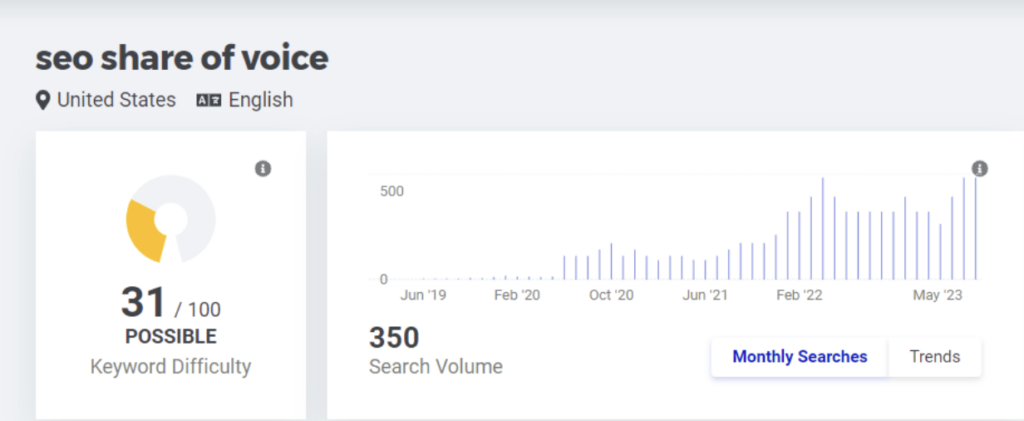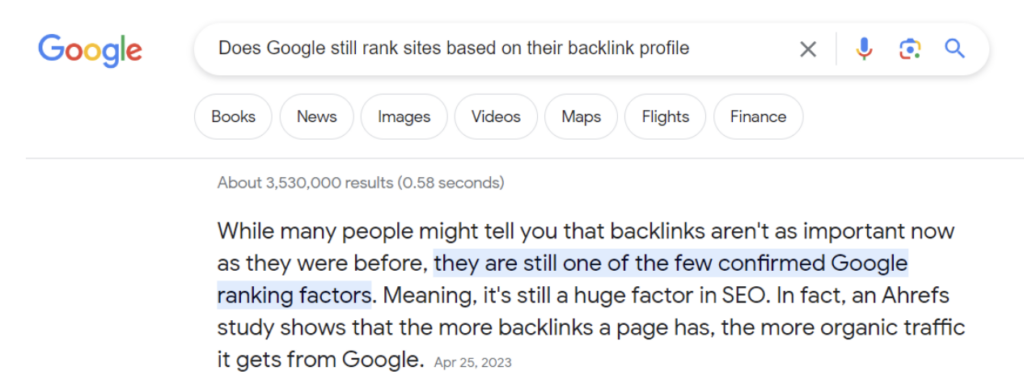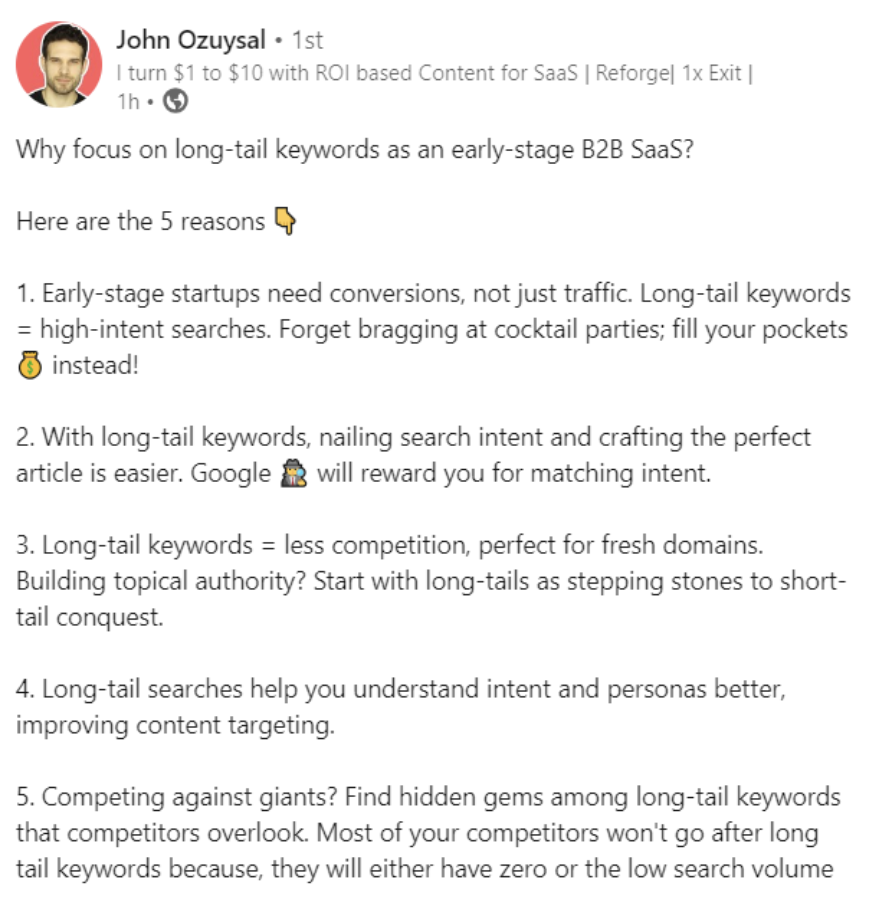Knowing the keywords that will bring a large traffic volume to your site is easy.
… the issue is ranking for them.
Gone are the days when site owners practiced keyword stuffing and maneuvered their way to the first page of SERPs. With search engine algorithms becoming increasingly intelligent, you will need a magic wand to move your site up the ranking ladder.
To help solve this ranking problem, most keyword research tools now have a keyword difficulty calculator that measures search query difficulties on a scale of 0 to 100.
This article will provide a basic understanding of keyword difficulty, why it matters for ranking on SERPs, and how to balance low-difficulty and high-difficulty keywords for better results in your SEO campaign.
What is Keyword Difficulty?
Keyword difficulty refers to the competition level or difficulty ranking for a specific keyword in search engine result pages. In other words, it indicates how challenging it would be to rank with other websites targeting the word or phrase.
For instance, keyword.com is a rank-tracking tool. We will want to rank on the first page for keywords relevant to our tools and their features.
Let’s say we target the keyword “SEO,” which has a high search volume. After conducting the competitor analysis, we discovered several well-established websites target the same keyword. More so, the keyword research tool assigns a difficulty score of 79 out of 100.
This score indicates that the keyword is highly competitive and challenging to rank for, requiring significant effort and optimization to achieve a top position in search engine results.
On the other hand, if we target other keywords like “SEO share of voice,” “rank tracking api,” “SERP tracker,” “keyword rank tracking tool,” and more. Based on the keyword difficulty metrics, these keywords have low search volume and low keyword difficulty.
These keywords are less competitive and require less effort and resources to rank on search engines’ first pages.
Related: In this blog post, we explain in detail why we target low-difficulty keywords.
Factors such as search volume, backlink profiles of the ranking websites, competition, content quality of websites targeting the keyword, quality of a model page, and more affect a keyword difficulty level.
Why Does Keyword Difficulty Matter for Ranking on SERPs
1. Helps You Assess Competition
In one of Mark Williams-Cook’s SEO anecdotes on LinkedIn, he said:
“Starting SEO is like joining in a marathon after it has started. There will be many people already ahead of you who have an advantage. It would be best if you outworked these people to catch up. If you join the race already running slower than them, you won’t progress, and all that will happen is you’ll get tired and frustrated.”
The knowledge of the level of competition in a race affects your preparation. This same principle is applicable in SEO.
Most SEO experts believe that search engines prefer big websites in ranking for keywords on their result pages. Even though this fact isn’t 100% accurate, we believe it’s necessary to know how authoritative the top-ranking websites are for your target search queries before optimizing them in your pages.
And you know, a crucial factor that influences a keyword difficulty metric is the level of competition. For instance, a new site will take a bank-breaking SEO strategy to rank on the first page for the keyword “SEO” rather than “rank tracker api.”
Why?
Their competition levels differ. Most importantly, we have more authoritative sites ranking for the first keyword than the other.
We did these two analyses just by checking their keyword difficulties.
2. Allocate Resources Effectively
By analyzing keyword difficulty, you can wrap your head around the following questions:
- Do I need to create a topical cluster around my target keyword before ranking on the first page?
- Do I need to go the extra mile in my link-building process to rank for my target keyword?
- Do I need to expand my content strategy process to rank for my target keyword?
Obviously, a keyword with high KD requires more than the plug ‘n play SEO strategy to build visibility on SERPs.
3. Set Realistic Expectations
Consider the example we gave in the first point.
A new site owner expecting to rank on the first page for the keyword “SEO” is an unrealistic expectation. In a world where big sites are vying for real estate on keywords with high search volume – the site will need a magic wand to see that desire become a reality.
Keyword difficulty metrics help you vet what keywords to use and what to expect in return.
4. Identify Conversion Potential
While keyword difficulty may not directly indicate conversion potential, it can indirectly help you identify keywords with higher conversion potential.
How?
- Understanding competition: keyword difficulty scores, often provided by SEO tools, reflect the competitiveness of a keyword based on factors like the number of websites targeting the keyword, their authority, and backlink profiles. Higher keyword difficulty suggests a more competitive landscape which can indirectly affect your conversion rate. Analyzing the difficulty score, you can gauge the effort required to rank well for that keyword.
- Correlation with search volume: keywords with high search volumes typically have higher competition. However, these keywords also tend to attract more potential customers. While high keyword difficulty alone doesn’t guarantee conversions, it indicates a larger pool of potential traffic if you rank well.
By targeting high-difficulty keywords with relevant content, you increase your chances of attracting interested users and converting them into customers.
By considering keyword difficulty, you can optimize your efforts, improve your chances of ranking well, and attract relevant organic traffic to your website.
What is a Good SEO Difficulty?
The notion of a “good” SEO difficulty can vary depending on your specific goals, resources, and competition within your industry. Generally, a good SEO difficulty strikes a balance between attainability and potential rewards.
Regarding keyword difficulty, keywords with too high KD are often considered difficult due to their competitiveness and the effort required to rank them.
Low-Difficulty Keywords Vs. High-Difficulty Keywords
Low-difficulty keywords are search queries with relatively lower competition in SERPs. These keywords are often easier to rank for and can help you attract organic traffic without facing intense competition.
On the other hand, high-difficulty keywords have intense competition in SERPs. These keywords are challenging to rank for due to the number of websites competing for visibility and the level of authority those websites possess. Many of these search queries are short-tail keywords characterized by broad terms covering various topics.
Related: How to Choose the Right Keywords to Track
When to Use High-Difficulty Keywords
1. When You Have A Strong Backlink Profile
Ranking for high-difficulty keywords isn’t child’s play. It would help if you could fight before contesting the battle. And a crucial prerequisite to rank for high-difficulty keywords is a strong backlink profile.
Someone may ask, Does Google still rank sites based on their backlink profiles?
Here is the answer from the featured snippet on the result page:
A website with a strong backlink profile is more authoritative, trustworthy, and vetted to have the experience and expertise Google desires. That’s why it’s easy for such a site to rank for highly competitive keywords.
But how do you build a strong backlink profile?
Alisha Rechberg mentioned five strategies for building a strong backlink profile in her blog post for Your Marketing People:
- Creating link-bait content, i.e., content people want to link to.
- Turn mentions into links
- Guest post for relevant sites
- Connect with your community by setting up your Google Business Profile and getting citations from local directories.
- Optimize anchor text naturally
Neil Patel also mentioned a few other points in his blog post on building a strong link profile:
- Use standard SEO tools to find and target your competitors’ backlinks
- Hold special events to get PR links.
A website with a strong backlink profile and other factors like content quality and search intent satisfaction will easily rank for keywords smaller sites will struggle to rank for after years of trying
2. When Building a Long-term SEO Campaign
High-difficulty keywords have long-term value due to having better search volumes.
Ranking for these keywords takes time and effort. It’s important to remain patient and persistent with your SEO campaign. Results may take time, but the consistent effort can help you achieve long-term success.
In conclusion, you need a proven and well-structured content strategy to suck the honey out of the high-difficulty keywords comb.
That’s why Daniel Chabert, Founder of Purplefire, says,
“A major online e-commerce platform needed help to rank for competitive high KD keywords related to their product assortment. A detailed and comprehensive content strategy was formulated by analyzing the keyword landscape and focusing on those high KD keywords that were still relevant to the business. This included optimizing on-page SEO elements, building quality backlinks, and creating in-depth, value-driven content around the selected keywords. Over time, this approach not only increased the website’s authority but also resulted in improved ranking on SERPs for those competitive high KD keywords, driving considerable growth in organic traffic and revenue.”
When to Use Low-Difficulty Keywords
1. At the Early Stage of Your Business
We’re sure you know that most long-tail keywords are low-difficulty keywords. These types of keywords should be the top of the list for early-stage startups.
John Ozuysal, Founder of House of Growth tells us “why” in one of his LinkedIn posts.
Note: The information John shared isn’t only relevant for early-stage B2B SaaS brands shared but for all startups in any niche.
To add, here is a case study from Isabel Ludick, Marketing Director at Pangolia, on how she grew her new site by targeting low-difficulty keywords
“When I started my website on juicers, I focused on publishing articles with very high keyword difficulty. So, one of the first articles I would publish on my brand-new site was focused on the keyword ‘best juicer.’
The issue was that the keyword difficulty for ‘best juicer’ was very high, so my new content website had almost no chance of ranking for that difficult keyword.
That didn’t work well. So, I changed my approach and focused on publishing articles that focused on long-tail keywords with low keyword difficulty. I started publishing articles like ‘best juicer for carrots’ and ‘Use for leftover juice pulp’.
Yes, those keywords had less search volume, but they also had a lot less competition, which meant that my site was finally able to start getting some decent traffic. And then my site grew in authority, making it possible to go after higher-competition keywords like ‘best budget juicer”
2. When Building Topic Authority
Building topic authority requires creating a cluster of sub-topics (with long-tail keywords) that are mostly low-difficulty so that Google sees them as more relevant.
Building a strong internal linking system with this strategy will create a web of content that makes your site carve real estate on the result page.
The cells behind this success are usually low-difficulty keywords.
3. To Increase Conversion in Various Stages of the Funnel
“This is what I’m doing for one of my clients – arc.academy. They create game design, animation, VFX, and concept art courses. However, the main keywords for these products are very competitive. So, we’re currently writing about adjacent keywords that can capture users on the upper end of the funnel.
An example of a keyword we did this for was “how long does it take to make a video game” (250 search volume and a KD of 6 based on our keyword research tool). Even though we don’t have any links to that page, it’s ranking on page one, and it’s even ranking in first position for some related keywords, and it’s bringing in traffic from a very relevant audience.” Velin Dragoev of ARC Academy
4. When You Want Quick Wins
“As an agency, we tend to target lower KD keywords when starting with a new client. This is because clients often get impatient, and showing them a quicker road to the top helps keep them engaged with us longer to the point where we can move the tougher KD keywords up the search results.” Robert Bentz, Chief Executive Officer at Purplegator
The low competition level and ability to easily rank on SERPs make low difficulty keywords the catalyst for quick wins in the SEO game. Coupled with the fact that most low-difficulty keywords are long-tail keywords with distinct search intent and high conversion rate potential, you can instantly turn the wheel of your SEO campaign.
How to Track Both High and Low KD
Firstly, it’s important to note that your keyword strategy mustn’t be one-sided. There is a need for balance to achieve the best result.
With this fact in mind, how do you capture high and low-difficulty keywords?
1. Consider Search Intent
We can’t overemphasize how Google prioritizes search intent as one of its major ranking factors. The Google BERT update allowed Google to understand keywords with conversational intent better. The focus is to improve the understanding of consumer intent by ensuring content addresses the users’ questions and is optimized accurately.
You need to understand the search intent of your topic and optimize your page with keywords relevant to the search intent.
2. Group Keywords By Difficulty Level
“A tip for structuring your keyword tracking is to group keywords by difficulty level, as this will help you organize and to track progress over time. As you start to rank, you can adjust your strategy to target more difficult keywords.” Jen MacDonald of Evolved Search
3. Consider Business Value
Business value supersedes keyword difficulty. A keyword that is outside the box in terms of business value is irrelevant irrespective of its potential.
Your business value should be the gauge for selecting the kind of keywords to use. Interestingly, most business-centered keywords are long-tail with high conversion-focused potential.
Strike a Balance Between Low and High-Difficulty Keywords
1. Keyword Effectiveness Index
The formula for KEI was first mentioned by Sumantra Roi, who created it for Wordtracker. This formula is basically the ratio between search volume and competition metric.
The first formula, according to Sumantra, was:
KEI = (P^2/C)*1000
Where P is the popularity of the keyword, otherwise known as the search volume, and C is the competition metric, otherwise known as the keyword difficulty.
The formula is a keyword search volume divided by its competition metric (keyword difficulty)
Keywords with low KEI have low search volume with high competition.
When KEI is high, it can mean that:
- The search volume is high
- The competition or keyword difficulty is low, or
- The search volume is high, and keyword difficulty is low.
We recommend you know the KEI of your keywords and target the ones with a high Keyword Effectiveness Index.
Please note: Just because a keyword has low KEI doesn’t mean it is not a good keyword to target. Such keywords are mostly short-tail ones requiring more effort, time, and resources to rank on the first page.
2. Proper Usage in Your Content
How often should you use your high and low-difficulty keywords in your blog post?
We requested insights from SEO experts to answer this question perfectly.
Among others, Anthony Johnson on Quora said,
“There is no definite answer to this question, as there is no specific number or ratio of high-difficulty and low-difficulty keywords that guarantee the success of a blog post.
However, it is generally recommended to use high-difficulty keywords sparingly and strategically, focusing more on creating high-quality content that provides value to the reader and naturally incorporates relevant keywords.”
The founder of the Epic Book Society gave a different response on Twitter.
Lastly, Grace, the Owner of Townster Creative, shared her view after we submitted a request on Helpab2bwriter. She said, “When writing keyword-driven blog posts and site pages, I mix 1-2 higher KD keywords and 2-3 lower KD keywords. The longer the piece, the more keywords I’ll include. I’ll use the lower KD keywords in critical SEO spots, like headers, and sprinkle the higher KD keywords throughout the body of the content to make sure Google knows exactly what this piece refers to.”
We recommend using your keywords naturally in your content, especially in your headings and across the body. However, it would be best to use your high-difficulty keywords in your headings and low-difficulty keywords across the body of your content.
SIDE NOTE: Even though your site has a weak backlink profile, optimizing your content with keywords that have business potential and are relevant to the page’s search intent, irrespective of their difficulty, puts your site on the path of gaining visibility for those search queries.
Final Words
Even after optimizing your content with keywords with the best Keyword Effectiveness Index, the big issue still needs to be settled, i.e., ranking for those keywords.
Several factors can affect your page from ranking for your targeted keywords, including ranking fluctuations, algorithm changes, and more.
However, you can fly over these hurdles through a simple process; rank tracking.
Rank tracking helps site owners monitor their ranking on SERPs for their target keywords, evaluate the effectiveness of their SEO efforts, and make informed decisions to improve their search visibility.
Interestingly, keyword.com makes it easy to automate this process.
Keyword.com is an SEO rank-tracking software trusted by reputable companies and SEO experts for tracking their keywords’ rankings on SERPs over time. More so, its Share of Voice feature makes it easy to discover who your true competitors are and how to outsmart them.
This software also features a rank tracker API that pulls unlimited data with 30-day historical SERPs access to make decisions based on your KPIs.
Try your free trial now and track unlimited sites.
Want to become a Keyword Master? Have a look at our Keyword Monitoring Guides and our Keyword Academy.



